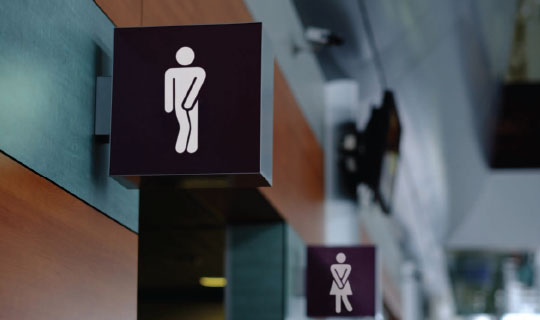
A leaky bladder or uncontrolled urination are uncomfortable and upsetting—but help is available.
Few medical issues still carry the social stigma of urinary incontinence (UI), the uncontrolled leakage of urine. UI is a common condition—up to a third of adults are estimated to suffer from it. However, the exact prevalence isn’t known, because so many are reluctant to admit the problem. This silence creates its own issues that may seriously impact patients.
“UI can dramatically affect the patient’s quality of life,” says Mark I. Miller, MD, a urologist with Robert Wood Johnson University Hospital (RWJUH) Rahway. “Patients are afraid to go out and socialize, fearing they’re going to wet themselves.” “I usually ask new patients about incontinence even if they haven’t come to see me for that problem,” says Aryeh Keehn, MD, a fellow urologist at RWJUH Rahway. “When I introduce the topic, it allows them to open up and share their symptoms. And share patients should, experts say, because a considerable amount of help is available.
Types of UI
Stress incontinence—which is related to physical, not emotional, stress—occurs when a patient loses urine during lifting, sneezing, coughing or laughing. During these activities, the belly squeezes the bladder and causes leakage. In men, this condition commonly occurs after surgical removal of the prostate gland, which weakens muscles around the urethra (the short tube that carries urine out of the body). In women, it is often caused by pregnancy and one or more vaginal deliveries, which stretch the muscles of the pelvic floor.
Urge incontinence involves the sudden, intense need to urinate, followed by involuntary urine loss. (An overactive bladder is urgency, usually experienced frequently, with or without urge incontinence.) Urge incontinence may be caused by an infection or by a condition such as stroke, Parkinson’s, multiple sclerosis or spinal cord injuries.
When an individual suffers from both stress and urge symptoms, he or she is diagnosed with mixed incontinence.
Another form of the condition, overflow incontinence, happens when small amounts of urine leak from a bladder that can’t be emptied sufficiently. Diabetes and spinal injuries can cause this, as can an enlarged prostate blocking the urethra.
Functional incontinence occurs in many older people. A person may have normal bladder control, but be unable to get to the toilet fast enough because of arthritis or other conditions that make them unable to move quickly.
Tools for treatment
At a basic level, options for managing UI include restricting fluids, especially before exercise and sleep, and using products like absorbent pads and adult diapers. Other techniques include:
- Kegel exercises, which focus on strengthening pelvic floor muscles to address both stress and urge incontinence. A physical therapist who has taken the appropriate courses can help both men and women learn to do these. “The principle here is similar to other muscle strengthening exercises,” says Linda Bernot, a physical therapist at RWJ Rahway Fitness & Wellness Center in Carteret. “You isolate a contraction and perform an increasing number of repetitions over time. We educate patients about how to contract muscles properly and set them up with a home program of daily exercises.” She also provides biofeedback, in which sensors help increase a patient’s awareness of the activity in the pelvic musculature.
- Medicine: To treat urge incontinence, a variety of oral medications can relax the bladder and allow it to store more urine.
- Botox injections, which paralyze the bladder muscle, are a favorite method of Dr. Miller’s. “I have a number of urge incontinence patients, mostly women, who had tried multiple medications that failed or produced side effects,” he says. “But after a simple Botox injection performed in the office, they finally found relief.”
- Tibial nerve stimulation, an in office procedure that involves providing temporary electrical impulses to the nerves responsible for bladder and pelvic floor function. Th e electrode is placed near the tibial nerve at the ankle.
- InterStim, a kind of pacemaker for the bladder that calms down erroneous messages from the bladder to the brain. “The procedure involves the implantation of a quarter-size device under the skin,” says Dr. Keehn. “In my practice, this has been effective for urge incontinence and lasts around 10 years.”
- The urethral sling, a surgical procedure for both men and women, involves a mesh placed under the urethra to give it support and compress it in order to prevent leakage.
- An artificial urinary sphincter, a surgical option for men only, involves a cuff placed around the urethra; when a button is pressed, the cuff inflates and squeezes the urethra so no urine can pass.
No matter what type of UI a patient suffers from, he or she should not be too embarrassed to ask for help, Bernot insists. “One of my patients was an elderly woman who was planning to travel across the country to a wedding and room with her granddaughter. She was afraid she’d be getting up during the night and disturb her, so she tried Kegel exercises. After her treatment, she was able to eliminate her nighttime bathroom trips. Age is no barrier to getting help with incontinence.”
How the bladder works
About every 10 to 15 seconds, small amounts of urine travel from the kidneys to the bladder by way of two thin, eight-to-10- inch tubes called ureters. The bladder swells into a round shape when it is full. Circular muscles called sphincters operate like rubber bands to keep urine from leaking into the urethra, the tube that allows urine to pass outside the body.
Nerves in the bladder signal that it’s full and needs to be emptied. When you go to the bathroom, the brain signals the bladder muscles to tighten, squeezing urine out, and the sphincter muscles to relax, allowing urine to exit the bladder.
To find a Urologist at RWJUH Rahway, call 888.724.7123. Physical therapists at the RWJ Rahway Fitness & Wellness Center at Carteret can help with Urinary incontinence. Call 732.969.8030.